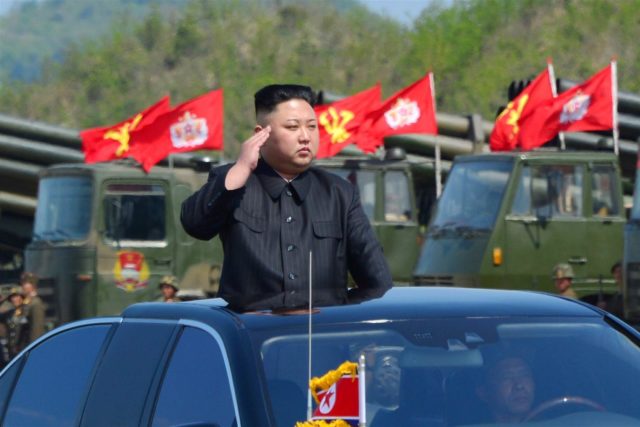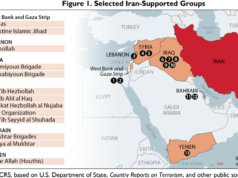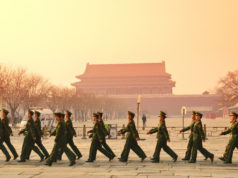
Do North Korea’s nuclear and missile programs represent deterrence to protect it from an attack by the United States, defensive weapons the world can live with, or are they an existential threat to South Korea, Japan and the United States that may require the use of U.S. military force to address?
These questions are being debated in light of major advances in both programs over the last year and go to the heart of difficult decisions that President Donald Trump must make concerning North Korea that could cause or prevent a cataclysmic war.
The Program as a Deterrent
Until recently, it was plausible to argue that North Korea might be developing ballistic missiles and nuclear weapons for defensive reasons – as a deterrent. North Korean officials have made this argument on many occasions, claiming their nuclear weapons and the missiles to carry them will prevent the Kim Jong Un regime from suffering the fate of Saddam Hussein in Iraq and Moammar Qaddafi in Libya.
The North Korean news agency said in January 2016 after North Korea’s fourth nuclear test, “History proves that powerful nuclear deterrence serves as the strongest treasured sword for frustrating outsiders’ aggression.”
In addition, there has long been a concern that any use of military force against North Korea would result in a deadly counterattack against South Korea and possibly Japan. Nearly half of South Korea’s population of 51 million lives within 50 miles of the demilitarized zone (DMZ). Ten million live in the capital, Seoul, only 30 miles from the DMZ. There are 28,500 U.S. troops in South Korea plus their family members.
A North Korean counterattack could kill millions. The North has an estimated 8,000 artillery cannons and rocket launchers near the DMZ, many hidden underground, which could fire an estimated 300,000 rounds on the South in the first hour of a counterattack. In addition, North Korea is believed to have hundreds of ballistic missiles capable of striking South Korea and Japan. The Washington Post reported on August 8, 2017 that the U.S. Intelligence Community had concluded that North Korea has “produced nuclear weapons for ballistic missile delivery, to include delivery by ICBM-class missiles.”
In the same article, The Post reported that the U.S. Intelligence Community believes the North has up to 60 nuclear weapons. North Korea also is known to have chemical weapons and is believed to have a biological weapons program.
Believing that North Korea’s nuclear weapons and missiles are deterrents it will never give up – and that the cost of attempting to force Pyongyang to do so would be too high – many conclude the world needs to learn to live with North Korea’s nuclear and missile arsenal and find a negotiated solution. This is the view of most arms control experts and American lawmakers, as well as the leaders of China, South Korea, and Russia.
Since mid-2017, North Korea, Russia, and China have been promoting a “freeze-for-freeze” proposal raised by Chinese President Xi Jinping last spring to reduce tensions with the North. Pyongyang would freeze its nuclear and missile programs in exchange for the United States and South Korea suspending joint military exercises. The Trump administration firmly rejected this proposal since it would not reduce the threat from these weapons and would weaken South Korean security.
In response to increased U.S. pressure on North Korea to end its nuclear program after its possible H-bomb test last September, Russian President Vladimir Putin said North Korea “will eat grass but will not stop their program as long as they do not feel safe.” During a recent visit to China, former Secretary of State Hillary Clinton urged negotiations over what she described as the overly antagonistic rhetoric of President Trump. Clinton also stated that “inaction is a choice as well” in dealing with the North Korean threat, an ironic comment given the failure of the Obama administration’s policy of inaction toward North Korea.
Bipartisan Policy Failures
In fairness to the Obama administration, North Korea’s nuclear program is a threat several Republican and Democrat presidents failed to resolve. The George H. W. Bush, Bill Clinton, and George W. Bush administrations all attempted diplomacy and concessions to entice Pyongyang to end its nuclear weapons program. North Korea repeatedly pocketed these concessions but failed to live up to its commitments. On many occasions, there was a cycle of North Korean provocations to start multilateral talks that it then would use to extract concessions, making vague commitments and pausing its provocations before resuming them to force new talks to extract more concessions.
According to former Secretary of State Colin Powell, North Korea started cheating on a 1994 nuclear agreement that the Clinton administration negotiated to halt the North’s nuclear weapons program, the Agreed Framework, “as the ink was drying.” This was a generous, one-sided agreement that provided North Korea with fuel oil and the construction of two light-water nuclear reactors. The Agreed Framework postponed sending spent fuel rods – a source of plutonium that can be used in bombs – out of the country and did not mention the one or two nuclear weapons the CIA believed North Korea had at the time.
The George W. Bush administration tried to strike a nuclear agreement with North Korea in 2008 and, as part of these negotiations, agreed to remove North Korea from the U.S. State Sponsor of Terrorism list in October of that year. A few weeks later, after North Korea got all the U.S. concessions it was looking for, it backed out of the agreement. A week before President Bush left office, North Korean officials announced they had weaponized 68 pounds of plutonium – enough for four or five nuclear bombs.
Strategic Patience’s Failure
The North Korean government ignored the Obama administration’s determined efforts in 2009 to negotiate a nuclear agreement by conducting a long-range missile test in April 2009 and its second nuclear test on May 21, 2009. After being repeatedly rebuffed by North Korea and preferring to concentrate on getting a nuclear agreement with Iran, the Obama administration adopted “Strategic Patience” in mid-2012, a policy of inaction toward North Korea, for the rest of the Obama years.
Under Strategic Patience, the Obama administration refused to offer North Korea any incentives to resume nuclear talks and insisted that talks would not resume until the North agreed to end its nuclear program. This policy reportedly was based on the assumption that taking no action on the North Korea situation was acceptable because Pyongyang was unlikely to make the technological advances to turn its primitive nuclear weapons program into a serious regional threat or a threat to the United States. Moreover, this policy also reportedly was based on the belief that the North Korean regime might collapse if left alone.
Strategic Patience was not designed to solve the North Korean threat. It was a policy to kick this problem down the road to the next president.
Under Strategic Patience, North Korea’s nuclear and missile programs surged after Kim Jong Un succeeded his father in December 2011. The North conducted its third nuclear test in 2013 and fourth and fifth tests in 2016. These tests were of increasing explosive yields. North Korea also claimed that it tested miniaturized nuclear devices and a hydrogen bomb in 2013. North Korea engaged in increasingly belligerent rhetoric during this period, including frequent threats to attack the United States with nuclear weapons.
There also was a surge in North Korea’s missile program. It conducted 56 missile tests between 2012 and 2016 versus only 31 under the regimes of Kim’s father and grandfather. These included more advanced long-range and medium range missiles, cruise missiles, and solid-fueled missiles.
Enter the Trump Team
North Korea has ignored tougher rhetoric by President Trump and continued to expand its nuclear and missile programs in 2017. It conducted an underground nuclear test on September 3, 2017 that it claims was an H-bomb and had an explosive yield of as much as 250 kilotons. This would be 25 times more powerful than North Korea’s second largest nuclear test in September 2016.
North Korea also conducted 20 missile tests in 2017. These included more advanced designs such as ICBMs, a solid-fueled medium-range missile and a new intermediate-range missile. North Korea’s November 29, 2017 ICBM test reached 2,800 miles on a lofted trajectory into space and may have been capable of striking anywhere in United States on a normal trajectory.
There are growing concerns that rapid advances in North Korea’s nuclear and missile programs over the last few years may have been due to assistance from other countries, possibly China, Russia, Ukraine or Pakistan, and outside experts. In addition, some experts – including Amb. John Bolton – worry that North Korea and Iran may be collaborating in their nuclear and missile programs and that Tehran may be “outsourcing” its nuclear weapons research to North Korea. That way, Iran would not be found in violation of a 2015 nuclear agreement, the Joint Comprehensive Plan of Action (JCPOA), meant to limit its nuclear weapons development.
President Trump’s anti-North Korean rhetoric, including a threat in his September 2017 UN General Assembly speech to “totally destroy” North Korea if it threatens U.S allies, and tweets criticizing North Korea as well as China and South Korea for not pressuring the North have been controversial, but they also appear to have succeeded in helping pass stronger UN sanctions and convincing China to enforce them.
An Offensive Force
President Trump has condemned prior U.S. administrations for negotiations with North Korea, which he claims amounted to appeasement. The president has been similarly critical of recent calls to negotiate a freeze on North Korea’s nuclear and missile programs because this would lock in these programs and because of concerns that Pyongyang would cheat on such an agreement.
A new factor affecting U.S. North Korea policy is that Pyongyang’s nuclear weapon and missile efforts have grown so much in size and sophistication that they can no longer be considered solely, or even primarily, a deterrent. These weapons probably are being developed as an offensive force that Pyongyang will one day use to achieve its most important foreign policy objective: unifying the Korean peninsula under its leadership. Such weapons could also be used to drive America forces from the region and possibly to attack U.S. territory. The possibility that these weapons are being developed with Iranian funding and could be shared with Iran also argues against considering them as only or mainly a deterrent the world can live with.
Due to miscalculation or error during tests of its ever more advanced nuclear weapons and missiles, as well as the North’s refusal to agree to talks to denuclearize the Korean peninsula, chances of a war with North Korea are increasing. The Trump administration took the right approach in 2017 by increasing sanctions and pressing nations worldwide to sever ties to the North. But President Trump now must weigh the risk of the limited use of military force given North Korea’s refusal to yield to peaceful pressure and the growing likelihood that the North plans to use these weapons in the future. Limited use of force might be declaring a missile no-fly zone over North Korea, shooting down any missiles Pyongyang tests, a naval blockade, and stopping and searching North Korean ships for WMD-related cargo.
Deciding to take such action may be the most difficult decision Mr. Trump will make as president. But I believe he has determined correctly that the global risk posed by North Korea’s nuclear and missile programs has become so serious that he cannot kick this threat down the road to the next president.
Fred Fleitz is the senior vice president of the Center for Security Policy and served as chief of staff to Under Secretary of State John Bolton from 2001-2005.





